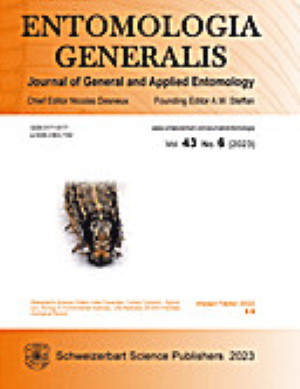看而不摸:鳞翅目中有毒物种的出现
IF 4.6
1区 农林科学
Q1 ENTOMOLOGY
引用次数: 0
摘要
鳞翅目昆虫的刚毛是保护它们免受天敌侵害的防卫性适应手段,因此鳞翅目昆虫会给人类和家畜带来多种健康问题。从 1984 年川本和熊田(Kawamoto and Kumada,KK)的首次全面尝试开始,已有多篇综述对有毒鳞翅目昆虫的多样性进行了探讨。在本综述中,我们验证并更新了 KK 的表格。更新后的毒鳞翅目名单包括 5 个超科、14 个科、208 个属和 576 个种,与 KK 相比,属的数量增加了 2 倍,种的数量增加了 2.9 倍。我们认为,至少包括一个毒种的属的物种总数可能更接近毒种的真实数量,是 KK 的 7 倍(3,620 种)。GBIF(全球生物多样性信息基金)中毒蛇物种的出现率要比无毒蛇物种的出现率高出1-4个数量级。毒液结构的存在与支系或地理区域的亲缘关系无关;Zygaenoidea、Lasiocampoidea 和 Bombycoidea 的许多物种都会产生毒液,但只有 Papilionoidea 和 Noctuoidea 的一些特殊类群才会产生毒液。在鳞翅目昆虫中,毒液可能有多个进化起源,但具体数量难以估计。医学和自然历史领域之间的知识差距需要通过研究生态学和毒理学的新方法来解决。本综述为医疗工作者提供了一种工具,使他们能够更好地了解所观察到的反应的起源,并改进对致病因子的识别。本文章由计算机程序翻译,如有差异,请以英文原文为准。
Look but do not touch: the occurrence of venomous species across Lepidoptera
Lepidoptera can cause several health issues in humans and domestic animals due to their setae, which are defensive adaptations that protect them from predators. The diversity of venomous Lepidoptera has been explored in several reviews starting from the first comprehensive attempt in 1984 by Kawamoto and Kumada (KK) who compiled a list of 228 species based on previous reviews; however, KK did not cite the original publications for listed species. In this review we validated and updated the KK table. The updated list of venomous Lepidoptera includes 5 superfamilies, 14 families, 208 genera, and 576 species, representing a two-fold increase for genera and 2.9-fold for species with respect to KK. The total number of species in the genera including at least one venomous species, which we argue is likely closer to the true number of venomous species, is 7 times higher (3,620). GBIF (Global Biodiversity Information Facility) occurrences for venomous species are 1–4 orders of magnitude higher than those of confamilial non-venomous species. The presence of venomous structures is independent of the relatedness of the clades or geographic region; venom is produced by many species of Zygaenoidea, Lasiocampoidea and Bombycoidea but only by some specialized groups in Papilionoidea and Noctuoidea. There are likely to be multiple evolutionary origins of venom within Lepidoptera, but the exact number is difficult to estimate. The knowledge gap between medical and natural history fields needs to be addressed with novel approaches to study ecology and toxicology. This review offers health practitioners a tool to better understand the origin of the reactions observed and to improve the identification of the causal agents.
求助全文
通过发布文献求助,成功后即可免费获取论文全文。
去求助
来源期刊

Entomologia Generalis
生物-昆虫学
CiteScore
7.10
自引率
18.80%
发文量
72
审稿时长
>12 weeks
期刊介绍:
Its scope covers all aspects of basic and applied research dealing with insects and more broadly with arthropods inhabiting wild, agricultural and/or urban habitats. The journal also considers research integrating various disciplines and issues within the broad field of entomology and ecology.
Entomologia Generalis publishes high quality research articles on advances in knowledge on the ecology and biology of arthropods, as well as on their importance for key ecosystems services, e.g. as biological control and pollination. The journal devotes special attention to contributions providing significant advances (i) on the fundamental knowledge and on sustainable control strategies of arthropod pests (including of stored products) and vectors of diseases, (ii) on the biology and ecology of beneficial arthropods, (iii) on the spread and impact of invasive pests, and (iv) on potential side effects of pest management methods.
Entomologia Generalis welcomes review articles on significant developments in the field of entomology. These are usually invited by the editorial board, but proposals may be sent to the Editor-in-Chief for preliminary assessment by the editorial board before formal submission to the journal. The journal also considers comments on papers published in Entomologia Generalis, as well as short notes on topics that are of broader interest.
 求助内容:
求助内容: 应助结果提醒方式:
应助结果提醒方式:


